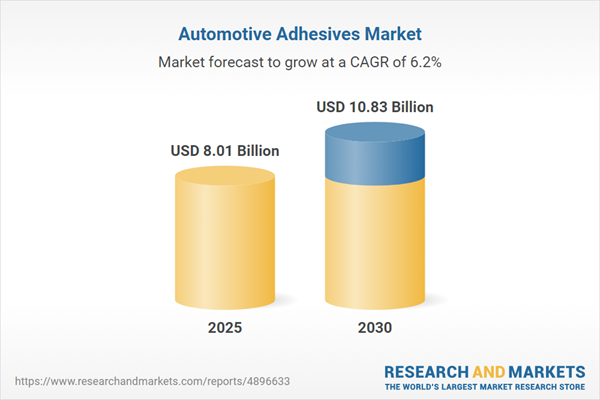Speak directly to the analyst to clarify any post sales queries you may have.
The automotive adhesives market is transforming in response to advancements in mobility, technology, and regulatory frameworks. Strategic investments now focus on innovation, sustainability, and supply chain resilience, positioning industry leaders to navigate market complexity with confidence.
Market Snapshot: Automotive Adhesives Market Size and Growth Outlook
The automotive adhesives market grew from USD 7.56 billion in 2024 to USD 8.01 billion in 2025. It is expected to maintain a healthy growth rate at a CAGR of 6.17%, reaching USD 10.83 billion by 2030. Market momentum is shaped by increased demand for advanced bonding solutions in both passenger and commercial vehicles, aligned with evolving industry trends such as electrification and light-weighting.
Scope & Segmentation: Market Coverage and Technological Focus
- Product Types: Acrylic adhesives, cyanoacrylate adhesives, epoxy adhesives, polyamide adhesives, polyurethane adhesives, rubber-based adhesives, and silicone adhesives
- Form Factors: Film, liquid, pellets, powder, tape
- Vehicle Types: Commercial vehicle (heavy and light), passenger vehicle
- Applications: Exteriors (emblem attachment, molding bonding), interiors (dashboard assembly, trim bonding)
- Distribution Channels: Offline, online
- End-User Categories: OEM, aftermarket
- Regions: Americas (North America, Latin America), Europe, Middle East & Africa (Europe, Middle East, Africa), Asia-Pacific
- Representative Companies: 3M Company, Henkel AG & Co. KGaA, Sika AG, H.B. Fuller Company, The Dow Chemical Company, Arkema Group, Huntsman International LLC, Evonik Industries AG, Hexion Inc., Tesa SE, Worthen Industries, Triton Middle East, ThreeBond International, Compagnie de Saint-Gobain S.A., PPI Adhesive Products Ltd., ORAFOL Europe GmbH, Nitto Denko Corporation, Lohmann GmbH & Co. KG, Lintec Corporation, L&L Products, Inc., Intertape Polymer Group, Avery Dennison Corporation, ATP Adhesive Systems AG, Master Bond Inc., SUMITOMO CORPORATION, PPG Industries, Jowat SE
- Key Technologies: UV curing, hot melt, pressure-sensitive adhesives, nano-reinforcements, multifunctional additives, waterborne and reactive hot melt systems
Key Takeaways: Strategic Insights for Decision-Makers
- Adhesives enable advanced lightweighting, energy efficiency, and crash performance, directly supporting next-generation automotive architecture.
- Electrification pushes demand for adhesives with strong dielectric strength and thermal management, driving co-development between OEMs and formulators.
- Regulatory demands for lower emissions and safer materials are accelerating the adoption of bio-based and solvent-free solutions across global production centers.
- The digitalization of manufacturing, including Industry 4.0 tools and predictive analytics, enhances process control and enables cost-effective customization.
- Regional variations—such as North American supply chain adjustments, European sustainability priorities, and Asia-Pacific’s production scaling—necessitate agile, market-specific product strategies.
- Innovation partnerships, strategic acquisitions, and R&D initiatives continue to differentiate market leaders and foster continuous improvement within portfolios.
Tariff Impact: Navigating 2025 US Tariff Changes
Planned US tariffs on imported chemical feedstocks will increase production costs for adhesives manufacturers. These adjustments drive the need for resilient sourcing structures and may prompt greater nearshoring and vertical integration. Suppliers and OEMs are having to renegotiate terms to maintain competitiveness, and consolidation or alliances are emerging as methods to ensure supply stability.
Methodology & Data Sources
This report utilizes a blend of primary and secondary research. In-depth interviews with industry experts provide firsthand context, while secondary data from journals, regulatory filings, and association reports reinforces the credibility of insights. Data triangulation and scenario analysis underpin all projections, delivering robust, actionable findings for industry stakeholders.
Why This Report Matters
- Assists executives in identifying innovation and portfolio expansion opportunities aligned with sustainability and regulatory priorities.
- Equips leaders to manage supply volatility and evolving trade policies confidently, with regional and technology-specific decision support.
- Provides a foundation for strategic planning in fast-evolving mobility and manufacturing environments.
Conclusion
The automotive adhesives market is evolving in step with industry transformation, from electrification to digital manufacturing. This report delivers executive insights to empower informed decisions, secure profitable growth, and ensure product portfolios meet future market and regulatory demands.
Additional Product Information:
- Purchase of this report includes 1 year online access with quarterly updates.
- This report can be updated on request. Please contact our Customer Experience team using the Ask a Question widget on our website.
Table of Contents
3. Executive Summary
4. Market Overview
7. Cumulative Impact of Artificial Intelligence 2025
Companies Mentioned
The companies profiled in this Automotive Adhesives market report include:- 3M Company
- Henkel AG & Co. KGaA
- Sika AG
- H.B. Fuller Company
- The Dow Chemical Company
- Arkema Group
- Huntsman International LLC
- Evonik Industries AG
- Hexion Inc.
- Tesa SE
- Worthen Industries, Inc.
- Triton Middle East
- ThreeBond International, Inc.
- Compagnie de Saint-Gobain S.A.
- PPI Adhesive Products Ltd.
- ORAFOL Europe GmbH
- Nitto Denko Corporation
- Lohmann GmbH & Co. KG
- Lintec Corporation
- L&L Products, Inc.
- Intertape Polymer Group Inc.
- Avery Dennison Corporation
- ATP Adhesive Systems AG
- Master Bond Inc.
- SUMITOMO CORPORATION
- PPG Industries, Inc.
- Jowat SE
Table Information
| Report Attribute | Details |
|---|---|
| No. of Pages | 187 |
| Published | November 2025 |
| Forecast Period | 2025 - 2030 |
| Estimated Market Value ( USD | $ 8.01 Billion |
| Forecasted Market Value ( USD | $ 10.83 Billion |
| Compound Annual Growth Rate | 6.1% |
| Regions Covered | Global |
| No. of Companies Mentioned | 28 |









